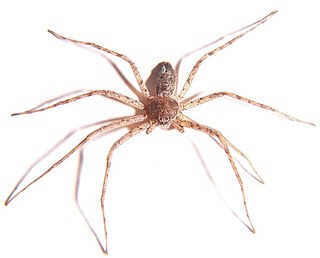In some versions of Greek mythology, Ophion, also called Ophioneus (Ὀφιονεύς) ruled the world with Eurynome before the two of them were cast down by Cronus and Rhea.

Crabs are decapod crustaceans of the infraorder Brachyura, which typically have a very short projecting "tail" (abdomen), usually entirely hidden under the thorax. They live in all the world's oceans, in fresh water, and on land, are generally covered with a thick exoskeleton and have a single pair of pincers. Many other animals with similar names – such as hermit crabs, king crabs, porcelain crabs, horseshoe crabs, and crab lice – are not true crabs.

The Thomisidae are a family of spiders, including about 175 genera and over 2,100 species. The common name crab spider is often linked to species in this family, but is also applied loosely to many other species of spiders. Among the Thomisidae, "crab spider" refers most often to the familiar species of "flower crab spiders", though not all members of the family are limited to ambush hunting in flowers.

Philodromidae is a family of spiders commonly known as philodromid crab spiders or running crab spiders. This family is superficially similar to the "true" crab spiders in the family Thomisidae.

A fiddler crab, sometimes known as a calling crab, may be any of approximately 100 species of semi-terrestrial marine crabs which make up the genus Uca. As members of the family Ocypodidae, fiddler crabs are most closely related to the ghost crabs of the genus Ocypode. This entire group is composed of small crabs – the largest being slightly over two inches across. Fiddler crabs are found along sea beaches and brackish inter-tidal mud flats, lagoons and swamps. Fiddler crabs are most well known for their sexually dimorphic claws; the males’ major claw is much larger than the minor claw while the females’ claws are both the same size.

Eurynome is a quite large and bright main-belt asteroid composed of silicate rock. Eurynome was discovered by J. C. Watson on September 14, 1863. It was his first asteroid discovery and was is named after one of the many Eurynomes in Greek mythology. This is the eponymous member of a proposed asteroid family with at least 43 members, including 477 Italia and 917 Lyka.

The Japanese spider crab , or Macrocheira kaempferi, is a species of marine crab that lives in the waters around Japan. It has the largest leg span of any arthropod. It is the subject of fishery and is considered a delicacy. Two fossil species belonging to the same genus have been found, Macrocheira ginzanensis and Macrocheira yabei, both from the Miocene of Japan.

Chionoecetes is a genus of crabs that live in the northern Pacific and Atlantic Oceans.

The crab-eating fox, also known as the forest fox, wood fox, or maikong, is an extant species of medium-sized canid endemic to the central part of South America, and which appeared during the Pliocene epoch. Like South American foxes, which are in the genus Lycalopex, it is not closely related to true foxes. Cerdocyon comes from the Greek words kerdo and cyon (dog) referring to the dog-and fox-like characteristics of this animal.

Majidae is a family of crabs, comprising around 200 marine species inside 52 genera, with a carapace that is longer than it is broad, and which forms a point at the front. The legs can be very long in some species, leading to the name "spider crab". The exoskeleton is covered with bristles to which the crab attaches algae and other items to act as camouflage.

The scale-throated hermit is a species in the hummingbird family, Trochilidae.
Plane or planes may refer to:
Hematodinium is a genus of dinoflagellates. Species in this genus, such as Hematodinium perezi, the type species, are internal parasites of the hemolymph of crustaceans such as the Atlantic blue crab and Norway lobster. Species in the genus are economically damaging to commercial crab fisheries, including causing bitter crab disease in the large Tanner or snow crab fisheries of the Bering Sea.

Around 65 species of crab occur in the waters of the British Isles. All are marine, with the exception of the introduced Chinese mitten crab, Eriocheir sinensis, which occurs in fresh and brackish water. They range in size from the deep-water species Paromola cuvieri, which can reach a claw span of 1.2 metres, to the pea crab, which is only 4 mm (0.16 in) wide and lives inside mussel shells.

Eurynome aspera, the strawberry crab, is a species of crab in the family Majidae.It is small (1–2 cm) and sometimes a vague strawberry colour.The carapace and legs are often encrusted with algae and mud which act as camouflage.

Diogenes heteropsammicola is a species of hermit crab discovered during samplings between 2012 and 2016 in the shallow waters of the Japanese Amami Islands. This hermit crab species is unique due to the discovery that they use living, growing coral as a shell. Crustaceans of this type commonly replace their shell as the organism grows in size, but D. heteropsammicola are the first of their kind to use solitary corals as a shell form. Heteropsammia and Heterocyathus are the two solitary corals that this hermit species has been observed as occupying. These two coral species are also used as a home by symbiotic sipunculans of the genus Aspidosiphon, which normally occupy the corals that the crabs were found inhabiting.












